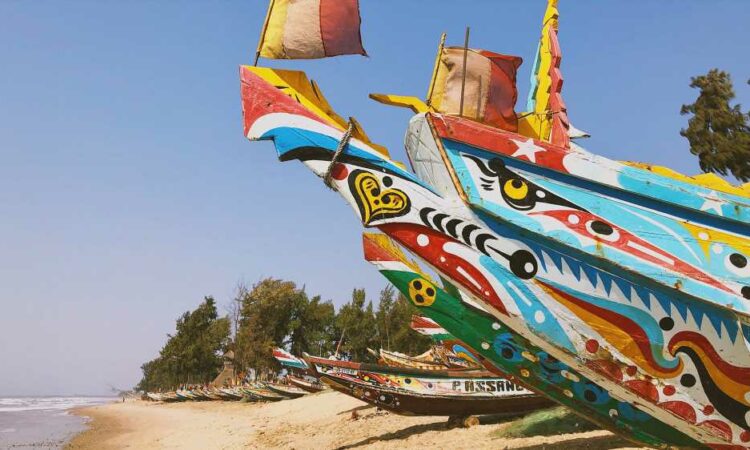The announcement that Air Senegal is launching twice-weekly flights between Senegal and the U.S. in September will likely boost Senegal as an attractive destination for U.S. travelers.
Air Senegal will launch U.S. service on Sept. 2, flying from the Senegalese capital of Dakar to New York JFK with continuing service to Washington Dulles. The West African airline, which began operations in 2018, will fly the route using an Airbus A330-900neo. The three-cabin aircraft will offer 32 lie-flat seats in business class, a 21-seat premium economy cabin and 237 seats in economy.
Senegal’s tourism industry has suffered greatly as a result of the Covid-19 pandemic, and the country is desperate to revive the sector. Senegal is an incredibly colorful cultural destination with its very own desert, no less than seven Unesco World Heritage Sites and endless things to see and do.
What to do in Dakar and beyond
There are a great number of attractions around Dakar, which has become a cultural hub to be reckoned with. Every two years, the city hosts the oldest and largest contemporary arts show in Africa: the Dakar Biennale, showcasing the best of Senegalese and African art. If you prefer seeing “live art,” then there is no better place than the Village des Arts.
Dakar is also a charming seaside town and a popular surfing destination with options for both beginning surfers and professional wave riders. Its location next to the sea means that the cuisine in Dakar is highly inspired by freshly caught fish, particularly thiof, the national fish. The Senegalese cuisine is exceptional, and there are a number of cooking classes available for foodie travelers. During these classes, they will learn how to make national dishes tchey bou djenn (rice, fish and steamed vegetables) or yassa (marinated fish or chicken).
A short drive from Dakar is Lake Retba, also called Lac Rose or “pink lake” by locals. A completely pink lake, this rare natural phenomenon is caused by a unique combination of bacteria and a high concentration of salt. Adventurous tourists can swim in the salty lake as long as they rub a generous quantity of shea butter on their skin. Other activities include quad biking around the lake, riding a camel or taking a cruise on a pirogue.
Nearby Lac Rose is the bustling Kayar village, a fishing community along the Atlantic coastline where donkey-drawn buggies are the most common form of transportation. Early in the morning, it is possible to see the spectacular return of the fishermen from the high sea where they have spent the night. They bring tons of fish, shrimp and lobsters in their brightly colored pirogues.
For more historical insights into the country, Goree Island is a must. A short boat ride from Dakar, this island was the departure point of slaves who were sent to the Americas. Now a Unesco World Heritage Site, the island showcases the cruelty and scale of the transatlantic slave trade in the Museum Maison des Esclaves (Slaves’ House). Despite its gloomy past, Goree Island today is an oasis of calm, with pastel-colored houses and narrow cobblestone streets.
Farther away from Dakar, but definitely worth a visit is the Sine-Saloum Delta with its unique ecosystem of mangroves and its abundant bird species. Travelers can hire a pirogue and sail out into the mangroves and the surrounding traditional Seerer fishing villages. The delta is home to incredible wildlife from dolphins to caiman and more than 100 species of birds, including dwarf flamingos and spoonbills.
Where to stay in Senegal
The area offers a variety of accommodation options from luxury resorts to camping sites. Keur Saloum in Toubacouta is a great option for travelers looking for comfort and luxury. This hotel offers spas and an infinity pool overlooking the river. For those who want a real and “authentic” experience, overnight stays in mud huts in the smaller villages are possible. For a truly authentic experience, travelers can camp at the rustic Mar Lodj, one of the islands in the delta.
Senegal also has its very own desert. Even if it is Africa’s smallest desert, it can still pack a punch. Situated midway between Dakar and the colonial city of Saint Louis, the Lompoul Desert is a popular tourist destination. A camel ride in the red dunes is definitely recommended as well as quad biking, board surfing, traditional bread making and spending a night under the stars. There are a number of attractive ecolodges in the desert, including the Ecolodge Lompoul, the Lompoul Desert Camp and Lompoul Lodge.
Covid-19 negative test required
All travelers to Senegal over the age of 2 years must present an original negative Covid-19 test result taken within five days prior to arrival. The results must be from a PCR test (not a rapid test) and be issued by a laboratory approved for such testing or a recognized international health organization. Verification of testing compliance will be undertaken by the airline prior to departure.
All travelers to Senegal may also be required to complete a passenger location form for public health officials, in accordance with recommendations from the International Civil Aviation Organization.
Source: Read Full Article

